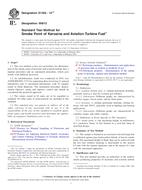We need your consent to use the individual data so that you can see information about your interests, among other things. Click "OK" to give your consent.
ASTM D1322-12e2
Standard Test Method for Smoke Point of Kerosine and Aviation Turbine Fuel (Includes all amendments And changes 12/8/2014).
Automatically translated name:
Standard Test Method for Smoke Point of Kerosine and Aviation Turbine Fuel
STANDARD published on 1.11.2012
The information about the standard:
Designation standards: ASTM D1322-12e2
Note: WITHDRAWN
Publication date standards: 1.11.2012
SKU: NS-16984
The number of pages: 12
Approximate weight : 36 g (0.08 lbs)
Country: American technical standard
Category: Technical standards ASTM
Annotation of standard text ASTM D1322-12e2 :
Keywords:
aviation turbine fuel, combustion properties, jet fuel, kerosine, radiant heat, smoke point, ICS Number Code 75.160.20 (Liquid fuels)
Additional information
| Significance and Use | ||||||||
|
5.1 This test method provides an indication of the relative smoke producing properties of kerosines and aviation turbine fuels in a diffusion flame. The smoke point is related to the hydrocarbon type composition of such fuels. Generally the more aromatic the fuel the smokier the flame. A high smoke point indicates a fuel of low smoke producing tendency. 5.2 The smoke point is quantitatively related to the potential radiant heat transfer from the combustion products of the fuel. Because radiant heat transfer exerts a strong influence on the metal temperature of combustor liners and other hot section parts of gas turbines, the smoke point provides a basis for correlation of fuel characteristics with the life of these components. |
||||||||
| 1. Scope | ||||||||
|
1.1 This test method covers two procedures for determination of the smoke point of kerosine and aviation turbine fuel, a manual procedure and an automated procedure, which give results with different precision. 1.2 An interlaboratory study was conducted in 2012 (see ASTM RR:D02-1747 for supporting data) involving 11 manual laboratories and 13 automated laboratories, with 15 samples tested in blind duplicate. The automated procedure demonstrated objective rating and superior control and should be considered the preferred approach. 1.3 The values stated in SI units are to be regarded as standard. No other units of measurement are included in this standard. 1.4 This standard does not purport to address all of the safety concerns, if any, associated with its use. It is the responsibility of the user of this standard to establish appropriate safety and health practices and determine the applicability of regulatory limitations prior to use. |
||||||||
| 2. Referenced Documents | ||||||||
|
We recommend:
Technical standards updating
Do you want to make sure you use only the valid technical standards?
We can offer you a solution which will provide you a monthly overview concerning the updating of standards which you use.
Would you like to know more? Look at this page.




 Cookies
Cookies
